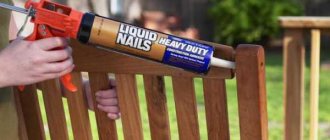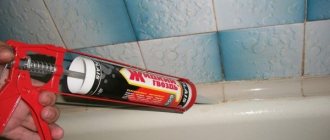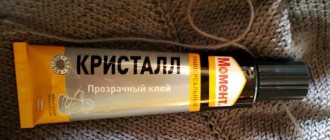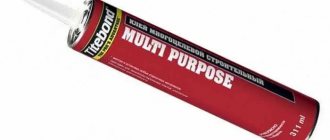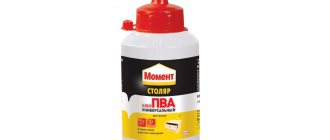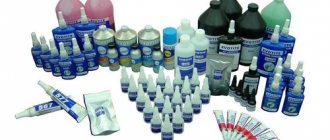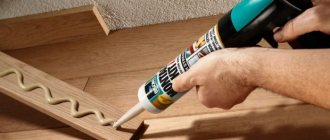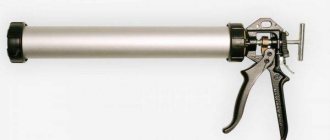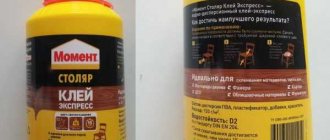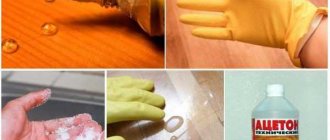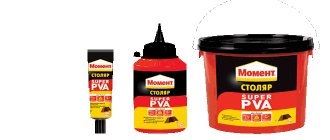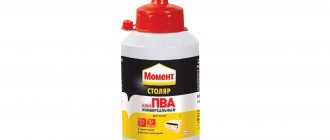Fastening of various building materials is often done using adhesive solutions. For different purposes, a huge number of compositions have been developed, which differ in application method, quality and constituent substances. A universal tool among adhesive options can be called Moment Montazh liquid nails. Even in this line there are many types, in order to choose the right glue, you need to understand the characteristics of the varieties. This will be discussed in detail below.
Purpose
Construction adhesive “Moment Installation” is used for the following purposes:
- for installing mirror bases on different planes;
- for attaching PVC panels;
- to attach shelves and decorative structures to any base;
- for fastening tiles.
Waterproof, which allows it to be used in conditions of excessive dampness. They can be used to glue tiles or mirrors in bathrooms, showers, swimming pools, kitchens, etc.
How to work with the composition?
Before applying glue, it is necessary to clean and degrease the surfaces. The nails are applied with a 2 cm indentation from the edge so that the glue does not come out of the seam when squeezed. If the surface is uneven, then apply it pointwise. For small surfaces, you can apply it with a line, to give greater rigidity and increase the adhesive force. For example, for ceiling tiles it can be applied in a continuous line around the perimeter, for wall panels - in small sections.
The glue should be applied according to the instructions. If the nails are acrylic, then apply glue and press, holding for several minutes until it sets. If the nails are rubber, then apply glue, connect the surfaces, and immediately separate them so that the solvents evaporate, making the bonding easier. Leave for 5-10 minutes and finally connect, pressing. If the structures are heavy, then use supports.
Types and composition
- Based on synthetic polymers. Additional components are solvents of organic origin, which explains the pungent aroma. Liquid nails react with plastic and PVC, so it is not recommended to connect surfaces made of these materials. The marking on the products of this group is “MR”, it is placed on the packaging. Synthetic compounds are highly durable and resistant to moisture. Due to easy flammability, use of the product near open flame is prohibited.
- Acrylic based. The marking indicated on the container is “MB”. They are neutral in composition, so they are suitable for work inside the house. Usually they install baseboards, fillets or PVC tiles.
Manufacturers of products display all information about the composition, main qualities and types of materials that can be glued together on the packaging and official website.
Gypsum stone - recommendations for gluing
As with the above repair work, it is important to properly prepare the work surface - correct unevenness, remove dirt, treat the wall and gypsum stone with an acrylic primer.
After this, an adhesive mass is applied to the stone. Decorative gypsum tiles are lightweight and can be glued with anything, including liquid nails. Apply glue to the entire surface using a comb spatula. By pressing the gypsum stone against the wall, make sure that it does not wobble. You need to lay it out one by one, taking into account the size. After complete drying, the decorative gypsum stone is painted.
Stamps
Glue Moment “Liquid Nails” is produced in 16 variations. Each has its own adhesive strength, differs in composition and is designed for a specific material.
- Express MV 50. Universal assembly adhesive, does not contain solvents, used for joining wood, PVC, insulating boards. You can plant baguettes, door jambs, and decorative elements.
- “One for everything. Super strong." Manufactured using Flexec technology. Plastic, monocomponent, has a high adhesive force, so it can be used to glue heavy and large elements. They can work on any surface with any porosity, seal cracks, and seal. Moisture accelerates the hardening of the joint, so it can be used in rooms with high dampness. They can be used to connect natural stone, concrete, brick. The product is not used for working with glass, copper, brass and PVC.
- “One for everything. Transparent". It has the advantages of the previous brand, it helps to seal seams in water, but not in conditions of constant immersion. Shelf life: no more than 15 months.
- Glue Express Decor. White acrylic composition. Quickly glues any materials, but maximum adhesive ability is achieved with hygroscopic surfaces. Suitable for fixing decor.
- “Moment Montage. Waterproof." It belongs to moisture-resistant products of class D. This is a universal composition marked MB-40. They can firmly glue any materials.
- "Super strong MVP 70. Transparent." Due to the gripping force of 70 kg/m. sq. quickly glues any materials. Typically, wall panels and interior design elements are mounted on it. There is also a white composition.
- "Superstrong Lux MV-100." It has the qualities of the previous brand, but its adhesion force is 100 kg/m. sq. To glue heavy elements to them, there is no need to use supports or clamps.
- “Extra-strong MP-55.” It is made on the basis of rubber. They can be used to glue heavy objects of any texture. After application, it forms a thin film that is dry to the touch, protecting the bonded surface from contamination. The strongest adhesion occurs at the first contact of the surfaces during the destruction of the protective shell, so it is not recommended to move the working elements after bonding.
- "Universal MP-40." Based on synthetic rubber. It is easy to wash off. You can glue fiberboard, concrete, marble masonry, natural stone, polystyrene panels, glass and fiberglass. Reliable and quick to engage. Can be stored at low temperatures down to -20 °C.
- "Installation moment for MP-35 panels." You can glue polystyrene and foam panels. The characteristics are similar to the “Universal MP-40” brand, it is just as durable, but can be easily washed off until completely cured.
- "Instant Grip MP-90." Designed for quick gluing of materials that do not absorb moisture. You can fasten polystyrene, foam, brick, plywood and stone bases.
- "Transparent combat MF-80." The base is Flextec polymer. The glue is characterized by fast setting and can be used as a sealant. Colorless, solvent-free. Smooth, non-absorbent materials can be joined.
- “Moment Fix. Universal", "Expert". Fixes almost instantly, has a coupling force of 40 kg/m. sq. Used for indoor work only. Between uses, the composition must be kept closed to prevent a film from forming. You can install ceiling slabs, floor moldings, wood and metal decor, sockets, wooden wall panels and fill small gaps up to 10 mm deep.
- “Moment Montage. Polymeric". It has an acrylic-water dispersed composition and has excellent adhesive properties. Can be used to fill deep cracks and becomes colorless after drying. Bonds paper, cardboard, foam plastic, wood, polystyrene foam surfaces, parquet mosaic and PVC. Release form: bottles.
Where is the best place to use Moment Montazh glue?
In order to properly clarify the issue and the scope of use of liquid glue, we must simultaneously consider what types of “Installation” exist today.
So, a series of heavy-duty adhesives that allow you to do without nails, screws, etc., consists of the following water-based products:
- "Montazh Express". It is used for attaching baseboards, trim, tiles, decorative elements and wall plaques. The glue is great for children's buildings, and for residential buildings in general. It is odorless and does not require additional solvents. Fairly good initial grip strength.
- “Editing Super Strong.” This type of liquid nails is used for fastening heavy structures - panels, window sills, decorative elements and door frames. It is also odorless and perfect for use in children's rooms. The initial grasp is simply tremendously powerful. The glue is capable of filling cracks whose thickness does not exceed one centimeter.
There are a number of other brands of glue that are made from synthetic rubber. This:
- “Universal installation”, which, as you may have guessed from the name, is suitable for working with any materials.
- “Installation Extra-Strength”, used for fastening particularly bulky structures and parts.
- "Installation for panels." Indispensable when attaching panels.
Specifications
| Characteristic | Rubber based | Water based |
| Compound | Contains toxic volatile substances that give the glue a pungent odor, so when working with it you need to carefully ventilate the room. | Does not contain toxic substances, no pungent odor. Has great gripping force. |
| Special Features | Moisture resistance, frost resistance (operating temperature can reach -40 °C) | Water resistance, frost resistance (up to -20 °C) |
| Color | Flesh color, there are white and colorless models. | White, colorless after drying. |
| Application | Installation, but can be used as a sealant. | For installation indoors and outdoors. |
| Type of bonded material | Almost anyone. | Various materials. |
| Type of bonded surfaces | Better glues smooth surfaces that do not absorb moisture. | The surface must absorb moisture. |
| Drying time | Some varieties can dry instantly. The average working time, depending on the brand, can be 10-30 minutes. It sets within a day, and liquid nails dry completely in a maximum of 7 days. | The working time of the train is 5-15 minutes. When completely dry, you can paint with acrylic paints. |
| Operating t°C | -12… +35 °C | +5… +30 °C |
| t°C storage | From -20 to +30 °C, fully restored after defrosting. | From +5 to +30 °C |
| Solvent | White Spirit. | Excess glue can be easily removed with a damp sponge. |
| Expiration date | 1.5-2 g. | 18 months |
| Consumption per 1m2 | Depends on the brand. | Depends on the brand. |
| Release form | Cartridges, tubes. Weight 0.125-0.4 kg. | Cartridges, tubes. Weight 0.125-0.4 kg. |
Description and main characteristics of liquid nails “Moment Installation”
A building material such as liquid nails is used as a universal adhesive for fastening a wide variety of materials. Among the main areas of application of the material, we will highlight construction and repair, as well as finishing work.
The unique properties of the glue are literally the stuff of legends. So, just one drop of it, applied to the surface, can withstand weight up to several tens of kilograms in a vertical position.
If we compare liquid nails at the moment of installation with other types of glue, such as PVA glue or bustilate, then it holds surfaces together two to three times stronger.
Moreover, when using liquid nails, the treated surface does not oxidize or corrode, fungi do not form on it, etc.
How to use glue
During work, you must follow safety rules.
The principles of working with “Moment Montage” will be as follows.
- Before starting gluing work, you need to clean the surfaces from dirt and foreign objects, sand them, then degrease them. The materials to be bonded must be at room temperature. The optimal air temperature for work is +10 °C and above. Some types of polymer adhesives can be used at subzero temperatures.
- If the glue is in the form of a cartridge, then before use you need to cut off the protective seal and put on the cap. The end of the cap is cut at an angle of 45° to the desired diameter. Next, the cartridge is installed in the construction gun: press the locking tab, pull the rod towards you, insert the cartridge into the gun body, push the rod back until the disk stops at the bottom of the cylinder. Make several idle trigger presses until the glue starts to come out. To stop feeding, press the locking tab. This movement reduces the pressure of the compound inside the cartridge.
- The glue is applied to one of the planes to be glued. This can be done in several ways. If uneven areas are glued, then the composition is applied pointwise. The dots have a size of 20 by 20 mm, applied every 0.2-0.3 mm. When you need to glue tiles or other materials of a small area, the glue is applied in waves, which enhances the primary adhesion. When gluing skirting boards and other narrow, long decorative elements, liquid nails are applied in a continuous strip. When the surface area is too large, a roller may be needed; it can be used to apply glue to even, smooth materials. A trowel is used to create greater surface contact and instant holding power. Using a notched trowel with a notch depth of 6 mm, the glue is evenly distributed over the material, with a distance of 2.5 cm from the edges.
- After application, the object is pressed tightly and fixed for a quarter of an hour. In order not to hold the element with your hands, you can secure it with masking tape or special fasteners until the glue dries completely.
- To prevent the adhesive from going beyond the joint, it can be limited by placing a toothpick on top.
- If the excess still protrudes beyond the seam, then the acrylic composition is dissolved by ordinary water, so it can be removed with a damp cloth, and white spirit will help to dissolve synthetic-based liquid nails. Excess glue is removed from porous surfaces after drying by careful cutting.
When you need to glue materials with low moisture absorption ability:
- the glue cannot be applied in a continuous layer, since in order to dry it needs to be in contact with air or ensure the presence of moisture;
- sometimes you need to apply glue first, and then after 5-10 minutes. separate the elements so the solvent can evaporate. Only after this can the parts be pressed tightly and secured.
Construction adhesive can be used as a sealant for joints up to 20 mm wide. It is necessary to carefully fill all cavities and press down the side surfaces tightly.
The average consumption of the product is 0.2-0.4 kg/m. sq. Synthetic compounds are characterized by rapid flammability, so it is better not to use near fire and not to smoke while working.
It is better to carry out gluing in a respirator, since toxic fumes from synthetic nails can cause harm to health.
Unused composition should be stored in a closed condition. Empty containers of liquid nails are disposed of as household waste. Do not allow any glue residue to enter the drain.
Can liquid glue be wiped off after drying?
Often during the application process, liquid nails extend beyond the edges of workable elements. So that their surface remains intact, smooth, clean and neat. The mixture can be wiped off in several ways, which depend on the degree of setting of the composition:
- when freshly applied, the mixture is wiped off using a strip of cloth or sponge pre-moistened in water or a mineral-based solvent;
- if the nails have already set, use a construction scraper, carefully removing excess glue, being careful not to damage the surface of the material, or a special acid or alkaline cleaner (sold in the store);
- from surfaces other than plastic, excess glue is removed by heating until the mass acquires a viscous state (up to 60 °C).
Products for cleaning surfaces from liquid nails
Monitor the drying time of the glue. Provided that the room temperature does not exceed 35 degrees Celsius and the humidity does not exceed 70%, the setting speed of liquid nails is 20 minutes, complete drying occurs within 24 hours.
source: //gipsohouse.ru/materials/2727-zhidkie-gvozdi-dlya-plastika.html
Liquid nails are a type of adhesive for cladding. They are great for gluing a variety of materials and elements of various shapes and weights, so they are useful for any repair and construction work.
Tips for beginners
- It is better to use a construction gun to apply the product. It can later be used to work with sealant.
- If work is carried out on newly constructed concrete walls, then it is better to postpone this for at least a month to allow the surface to dry and the concrete to set. If you intend to glue PVC panels to painted walls, they must first be sanded. If the surface does not absorb moisture well, then it is better not to use acrylic nails or to prime the surface first.
- To increase the adhesive properties of polystyrene foam, it is first coated with wood glue, which is diluted 1 to 1 with water. After drying, you can begin to apply the glue.
Complete curing of the composition requires from 12 to 24 hours; during this time it is not recommended to load the glued surfaces, so as not to reduce the quality of the gluing.
Laying ceramic tiles
Laying tiles on a wall or stone (regular or gypsum) is a difficult and painstaking task. But it is still possible if you follow the instructions. More often, liquid nails are used to restore fallen parts, since they are noticeably more expensive than traditional tile adhesive.
Depending on the weight and size of the tile, a specific adhesive application pattern is selected.
How to properly apply adhesive solution to ceramic tiles
The adhesive is applied with a snake onto the heavy and extensive surface of the tile. Spot application is suitable for facing work if the material is not heavy. After reading the instructions regarding applying a dot, grid or snake onto the tile, choose a tool: a construction gun or a spatula. The adhesive mass is first applied to the entire surface of the cladding material, and then they begin to attach it to the wall.
The first row of tiles is laid out against the batten, pressed and held for several seconds. For better fastening, use a wooden hammer. Subsequent rows are glued in the same way. The composition dries completely within a day. Until this time, the cladding is protected from various physical influences. Grouting of joints is acceptable after a week.
To give the facing work a special aesthetic appearance, different schemes are used for laying out the slabs:
- Checkers;
- Deck;
- Network;
- Herringbone;
- Labyrinth.
If a ceramic tile has fallen off and is not damaged, you should not replace it with a new one. To re-attach there is a certain sequence of actions:
- The previous mortar is removed from the wall and tiles, since the tiles will not stick otherwise;
- Liquid nails are applied to the surface of the tile;
- The fallen element is applied to the wall and held for the time indicated on the package;
- The seams are sealed.
Mode of application
The gluing instructions are useful for those new to installation.
When using the composition, they are guided by the principle of surface cleanliness. The part and base are clean before and after work. At regular intervals, cleaning must be done in different ways.
Preparing the base
The following operations are carried out with the base:
- Cleaning. Depending on the surface, rags, brushes, wet washing, and detergents are used.
- Drying. Relevant both when using water (washing detergents) for cleaning and without. A dried base will ensure good adhesion.
- Processing with sandpaper. Roughness significantly increases the bonding strength. Therefore, if possible (when the base is wooden, from a material of similar strength), sandpaper processing is performed, after which the base is roughened.
When the surface is ready, apply the adhesive mass. From a tube or dispensing syringe, apply an equal amount in strips along the edges, a spot amount in the center of gravity or along the entire perimeter of the adhesive element.
Cleaning the surface of excess glue
After the mass is distributed over the part, pressing is performed. In the marked place on the base, first press the corner, then the entire element.
“Express” only needs a few minutes until it sets completely. The final cleaning work is carried out after a few hours. Excess is removed using spatulas and a damp, soapy cloth. Handle the rag carefully so as not to dislodge the fresh adhesive.
"Montazh Express" is an excellent replacement for dowels, nails, screws and other fasteners that spoil the interior aesthetics of the house.
What it is
When purchasing liquid nails, not everyone reads the instructions for use. The material is so widespread and accessible that it seems that there are no surprises to be expected from it. But this is not so, since the general name hides several solutions with different characteristics. In the original version, the glue consisted of artificial rubber with the addition of polymers.
When it first appeared, especially plastic clay, which was mined in Texas, was used as a fine filler. Since such raw materials could only be used in America, and the adhesive composition turned out to be successful, experiments began with other additives. Thanks to this, many varieties of the product appeared, but the name remained.
Instagram positive_magazin_krasok
The range of liquid nails is very wide. The general name hides several solutions with different characteristics.
- Construction Materials
What can be glued with liquid nails: 8 materials
